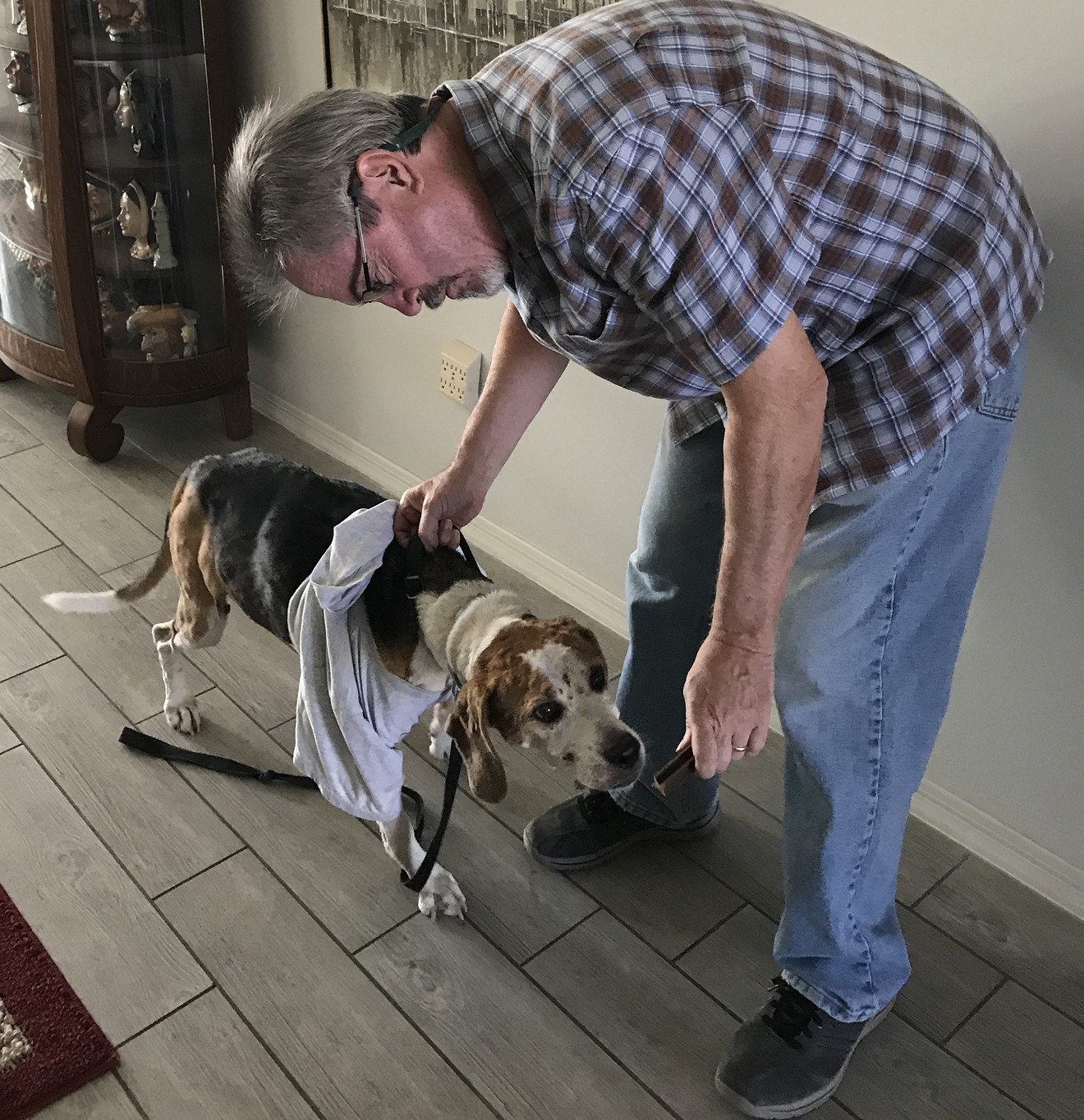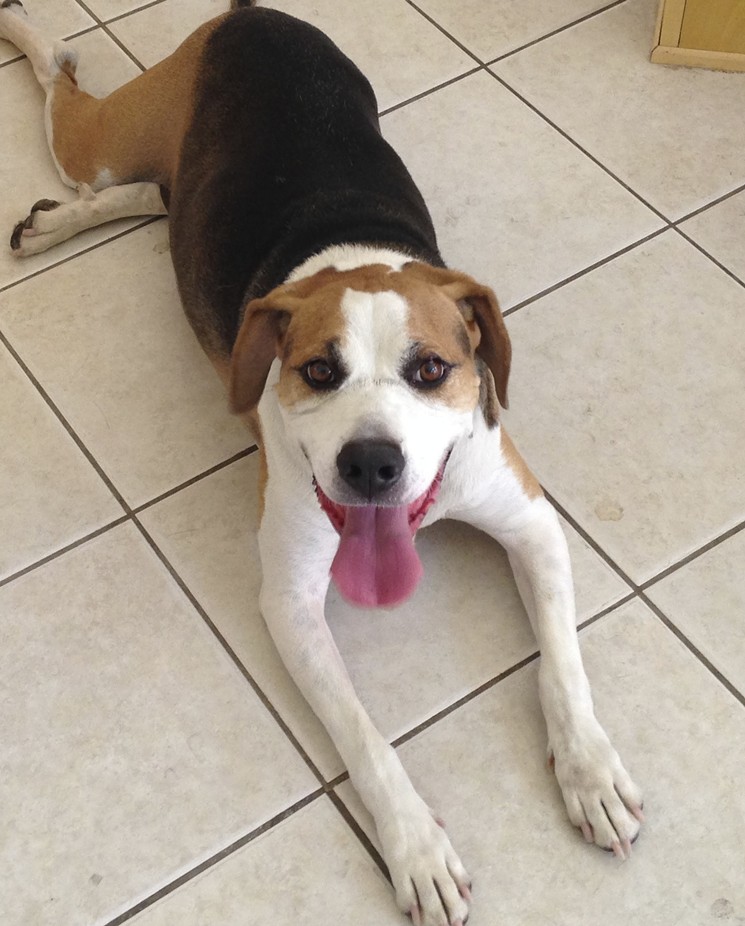My wife and I have owned dogs for more than 30 years, but we’d never had to make this decision before. Our first, Duchess, a cocker spaniel, simply wandered off at age 14 as if she didn’t want us to see her die. Our second, a magnificent German shepherd bitch named Pepper, passed away on the operating table at age 11.
Tyrone, a rescue beagle mutt who was almost 13, had cancer. Surgery had failed. He was either miserable or drugged most of the time. So last week my wife said her good-byes, then I took him to the Banfield Pet Hospital on Baseline Road in Phoenix.
After a comforting chat with the veterinarian, Dr. Drew Pearson, I knew we made the right decision.
“Take as much time with him as you want,” said Dr. Pearson, who left Ty and me alone after placing a catheter in his right front leg.
I told Tyrone how important he was to our family, how much we were going to miss him. We talked about the hundreds of miles we had walked together, encountering coyotes, cats, and even a rattlesnake.
Our adventures had caused both of us some pain. One spat with two snarling dogs left me with torn ligaments in my knee as I tried to hold him back. A run-in with a jumping cholla bush on Lookout Mountain put Tyrone in the hospital, covered from tail to nose with cactus needles. I can’t tell you how brave he was walking down the mountain until we reached the car for the drive to Banfield.
Then I began to cry. Ty looked up at me as if to say everything was going to be all right.
I asked Dr. Pearson to return.
Ty lay on a green blanket as the vet first injected him with a strong sedative. I held his head and scratched him behind the ears as his consciousness faded.
I thought about how much he had comforted me during a year when I was unemployed. I smiled thinking about the first time we left him alone in the basement after Pepper had died. He panicked and actually clawed through a door.

Tyrone the beagle was none too happy at first when a German shepherd puppy, Dee Dee, joined the family.
Stuart Warner
The tears continued.
Dr. Pearson pulled out another needle. This one contained a barbiturate mix. It would stop Tyrone’s heart and brain functions.
I continued to stroke his black, brown, and white fur as his breaths came slower and slower.
Seconds later, the vet put his hands on Tyrone’s chest.
“He’s passed,” he said.
I bit my lip. “Good-bye, buddy,” I said, petting him one last time. “You were a good boy.”
Dr. Pearson gently wrapped the green blanket around Ty, then carried him off. The final process had taken 10 minutes at most.
Then I bawled all the way home on the slow drive through the afternoon traffic on Baseline.
But I also began to wonder: If we can terminate the lives of our animals with such dignity, why can’t we at least do the same for humans who we have been condemned to die?
The Eighth Amendment of the Constitution of the United States says we must. But we so often fall short.
In July 2014, Arizona killer Joseph Wood gasped more than 600 times during the two hours it took to execute him. The state used a sedative, midazolam, that has produced several such gruesome deaths at our nation’s penitentiaries.
For a variety of reasons, we have struggled to find a combination of legal drugs that works well on humans, in part because the manufacturers don’t want their products to be associated with death.
Arizona was busted for importing illegal execution drugs. Nebraska got caught wasting $54,400 of taxpayer money trying to buy expired drugs from India. So that state is going to try an untested combination of four drugs on human guinea pigs.
Apparently, size isn’t the problem.
Tyrone weighed only 52 pounds, but a statement from Banfield Pet Hospitals said the procedure they use works on the largest dogs, even horses, though it is often difficult to get them to lie down even when they are sick.
Banfield won’t comment on any comparison of euthanizing humans and pets.
Dale Baich will. Baich is the assistant federal public defender in Phoenix. He has been on the forefront of the fight over lethal-injection drugs for years.
Euthanizing a pet “is a medical procedure based upon scientific research,” he said. “The process is transparent. The qualifications of the veterinarian and the source of the drugs are known.
“Executions by lethal injection are shrouded in secrecy,” Baich continued. “And, there is no scientific research on how we kill human beings. … Departments of corrections are left to experiment on their own and do so in secret.
"We see states like Nebraska and Nevada making it up as they go along. ... Other states, like Arizona and Texas, continue to search for drugs overseas and on the grey market in violation of the law.”
Baich has watched men die. So have my reporters.
I have not.
After sitting through Tyrone’s death, though, I can’t imagine what that would be like.
It just made me more certain that we need to treat people, even you believe they are the worst of us, as humanely as we do dogs. Just maybe someone cared as much about them as we did Tyrone.













